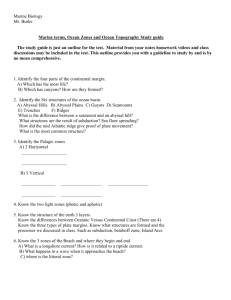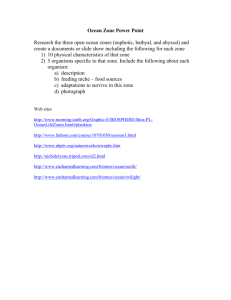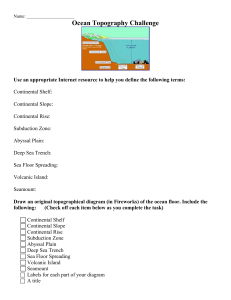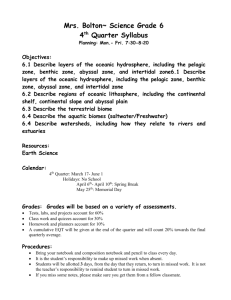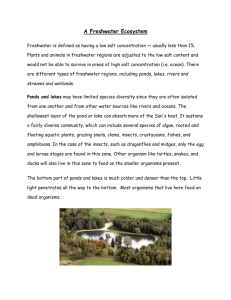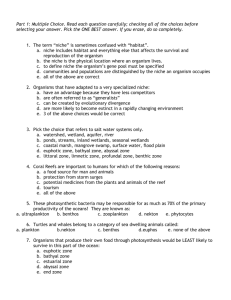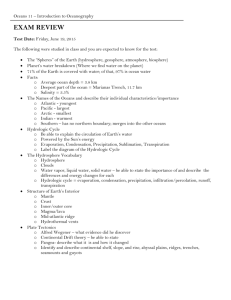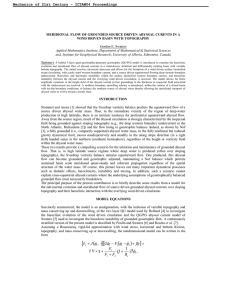The Abyssal Zone: Deep Sea Ecosystem Presentation
advertisement
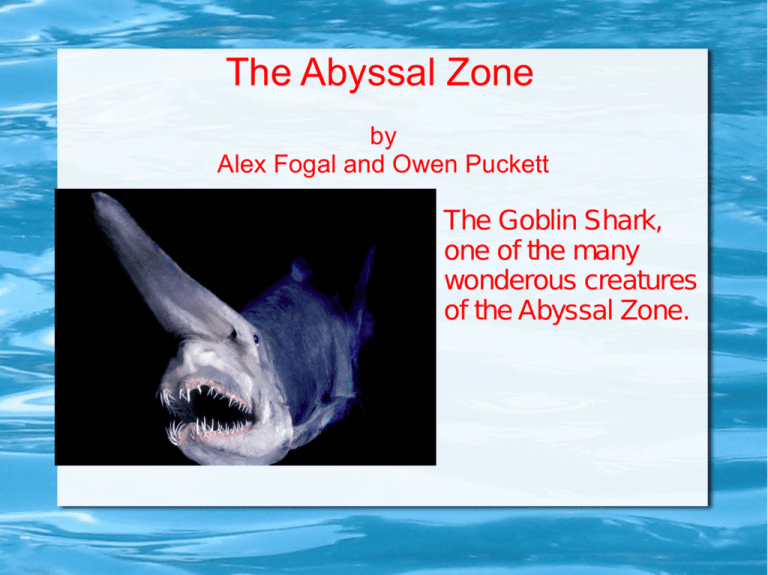
The Abyssal Zone by Alex Fogal and Owen Puckett The Goblin Shark, one of the many wonderous creatures of the Abyssal Zone. Geographic Location There are abyssal regions in all oceans of the world. Some of the abysses are: The Puerto Rico Trench at a depth of 27,460 feet (8,372 meters). The Marianas Trench is about 2,550 kilometers long (1,580 mi). The Laurentian Abyss is off the eastern coast of Canada in the Atlantic Ocean approximately 6,000 meters in depth. Above: Dark blue shows abyssal zones Left: The Marianas Trench is located in the South Pacific Ocean Land Forms For the most part the abyssal zone is made up of trenches, guyots, and plains. Left: A diagram showing abyssal zone land features Creatures The organisms that live at the extreme depths of the ocean have adapted to survive in high pressure and complete darkness. They have slow metabolisms and can live in water with very little oxygen. They are not affected much by mankind because we can't easily get there. Plants ● ● ● There are no plants found in the abyssal zone. This is because there is no sunlight to support photosynthesis. Instead, tiny microbes serve as producers by using chemosynthesis and oxidizing hydrogen sulfide from ocean floor vents. This provides nutrients for most animals. Hydrogen sulfide chemosynthesis: CO2 + O2 + 4H2S → CH2O + 4S + 3H2O Chemosynthesis Climate The average temperature for the abyssal zone is 0-4 degrees Celsius. ● The abyssal zone gets no precipitation because its below 3000m under water. ●It isn't affected by the climate above water. ●The water is calm down there as well. ●The pressure in pounds per square inch is 11,000 psi. ● Interesting Facts and Places The abyssal zone is 300,000,000 km2 or 83% of the ocean. Movie producer James Cameron went to the bottom of the Marianas Trench in a special submarine. An interesting place to go may be ”The Challengers Deep” the deepest part of the Marianas Trench and on Earth. Challengers Deep is named after the only submarine to ever reach its depths. Marianas Trench is deeper than Everest is high. Reflection Part 1 Our ecosystem is unique because it houses the only organisms that don't depend on the sun for nutrients. It has the highest pressures found on the Earth. The organisms that act as the producers are called cormophytes they don't use photosynthesis because there is no sunlight in the abyssal zone, instead the use chemothynthesis, but otherwise the use photosynthesis. If the ocean biome didn't exist then many regions wouldn't have enough food as may regions are dependent on fish as food. Some positive actions humans have on the ocean biome are population control, cleaning up the ocean and making some ocean preserves. Some negative effects humans have on the ocean are pollution and over fishing. Reflection Part 2 This ecosystem is well adapted to it's biome because the organisms down in the abyssal zone can't use photosynthesis because sunlight can't make it there, instead they've adapted and use chemosynthesis. Another adaptation is luminescence, the fish use it for light and predation. Some factors that affect to the balance of this ecosystem are: chemosynthesis and bioluminescence. These are vital for survival, the little plankton feed on chemosynthesis, the small fish use bioluminescence so attract the plankton, and using the same technique the bigger fish feed on the smaller ones. The elements of our ecosystem are connected by the food chain, if just one species become extinct the whole abyssal zone is likely to fail. Bibliography www.seasky.org/deep-sea/dragonfish.html www.brighthub.com/environment/science-environmental/articles/60013.aspx# en.wikipedia.org/wiki/Colossal_squid en.wikipedia.org/wiki/Anglerfish www.waterencyclopedia.com/Mi-Oc/Ocean-Basins.html /wiki.answers.com/Q/What_are_the_main_primary_producers_in_the_abyssal_zone forum.thefreedictionary.com/postst6788p3_Ocean-Scenery-Collection.aspx ocean.nationalgeographic.com/ocean/photos/deep-sea-creatures/ en.wikipedia.org/wiki/Chemosynthesis www.teara.govt.nz/files/di8960enz.jpg /www.ask.com/wiki/Oceanic_basin /en.wikipedia.org/wiki/List_of_submarine_topographical_features /www.dailymail.co.uk/sciencetech/article-2118723/James-Cameron-descends-thePacifics-Mariana-trench.html www.oppapers.com/essays/Abyssal-Zone/244715
